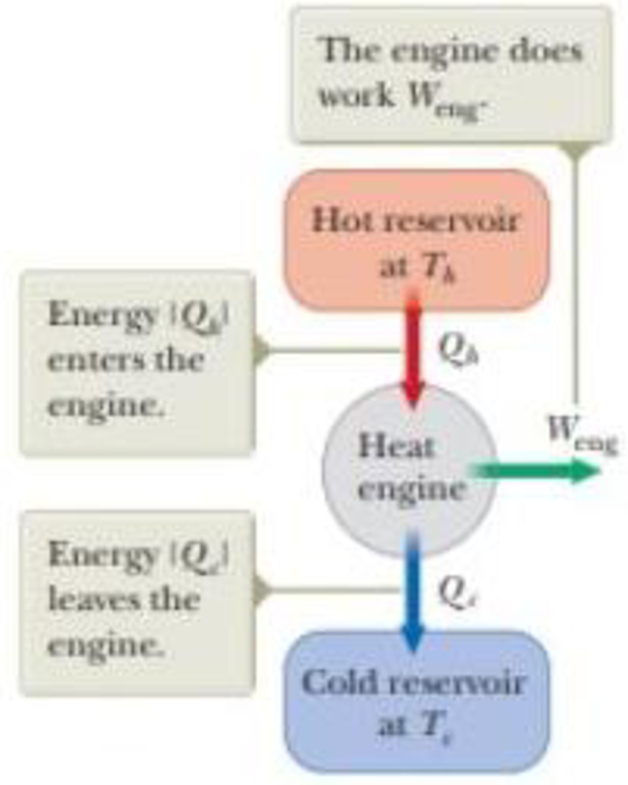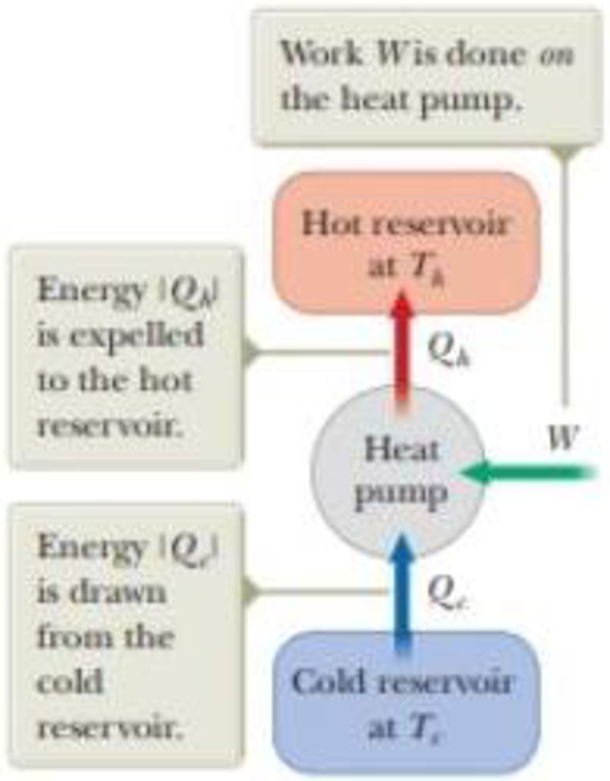
Bundle: Physics For Scientists And Engineers With Modern Physics, Loose-leaf Version, 10th + Webassign Printed Access Card For Serway/jewett's Physics For Scientists And Engineers, 10th, Single-term
10th Edition
ISBN: 9781337888585
Author: Raymond A. Serway, John W. Jewett
Publisher: Cengage Learning
expand_more
expand_more
format_list_bulleted
Textbook Question
Chapter 21, Problem 9P
If a 35.0% -efficient Carnot
Figure P21.2 Schematic representation of a heat engine.

Figure P21.4 Schematic representation of a heat pump.

Expert Solution & Answer
Trending nowThis is a popular solution!

Students have asked these similar questions
Can you explain this using nodal analysis
With the nodes I have present
And then show me how many KCL equations I need to write, I’m thinking 2 since we have 2 dependent sources
state the difference between vector and scalar qu
Please don't use Chatgpt will upvote and give handwritten solution
Chapter 21 Solutions
Bundle: Physics For Scientists And Engineers With Modern Physics, Loose-leaf Version, 10th + Webassign Printed Access Card For Serway/jewett's Physics For Scientists And Engineers, 10th, Single-term
Ch. 21.1 - The energy input to an engine is 4.00 times...Ch. 21.2 - The energy entering an electric heater by...Ch. 21.4 - Three engines operate between reservoirs separated...Ch. 21.6 - (a) Suppose you select four cards at random from a...Ch. 21.7 - An ideal gas is taken from an initial temperature...Ch. 21.7 - True or False: The entropy change in an adiabatic...Ch. 21 - A particular heat engine has a mechanical power...Ch. 21 - The work done by an engine equals one-fourth the...Ch. 21 - Suppose a heat engine is connected to two energy...Ch. 21 - During each cycle, a refrigerator ejects 625 kJ of...
Ch. 21 - A freezer has a coefficient of performance of...Ch. 21 - Prob. 6PCh. 21 - One of the most efficient heat engines ever built...Ch. 21 - Prob. 8PCh. 21 - If a 35.0% -efficient Carnot heat engine (Fig....Ch. 21 - Prob. 10PCh. 21 - Prob. 11PCh. 21 - A power plant operates at a 32.0% efficiency...Ch. 21 - You are working on a summer job at a company that...Ch. 21 - Prob. 14PCh. 21 - Prob. 15PCh. 21 - Suppose you build a two-engine device with the...Ch. 21 - A heat pump used for heating shown in Figure...Ch. 21 - Prob. 18PCh. 21 - An idealized diesel engine operates in a cycle...Ch. 21 - Prob. 20PCh. 21 - Prob. 21PCh. 21 - A Styrofoam cup holding 125 g of hot water at 100C...Ch. 21 - A 1 500-kg car is moving at 20.0 m/s. The driver...Ch. 21 - A 2.00-L container has a center partition that...Ch. 21 - Calculate the change in entropy of 250 g of water...Ch. 21 - What change in entropy occurs when a 27.9-g ice...Ch. 21 - Prob. 27PCh. 21 - Prob. 28PCh. 21 - Prob. 29PCh. 21 - Prob. 30APCh. 21 - Prob. 31APCh. 21 - In 1993, the U.S. government instituted a...Ch. 21 - In 1816, Robert Stirling, a Scottish clergyman,...Ch. 21 - Prob. 34APCh. 21 - Prob. 35APCh. 21 - Prob. 36APCh. 21 - A 1.00-mol sample of an ideal monatomic gas is...Ch. 21 - Prob. 38APCh. 21 - A heat engine operates between two reservoirs at...Ch. 21 - You are working as an assistant to a physics...Ch. 21 - Prob. 41APCh. 21 - You are working as an expert witness for an...Ch. 21 - Prob. 43APCh. 21 - Prob. 44APCh. 21 - A sample of an ideal gas expands isothermally,...Ch. 21 - Prob. 46APCh. 21 - The compression ratio of an Otto cycle as shown in...
Knowledge Booster
Learn more about
Need a deep-dive on the concept behind this application? Look no further. Learn more about this topic, physics and related others by exploring similar questions and additional content below.Similar questions
- No chatgpt pls will upvotearrow_forwardThe shear leg derrick is used to haul the 200-kg net of fish onto the dock as shown in. Assume the force in each leg acts along its axis. 5.6 m. 4 m- B Part A Determine the compressive force along leg AB. Express your answer to three significant figures and include the appropriate units. FAB = Value Submit Request Answer Part B Units ? Determine the compressive force along leg CB. Express your answer to three significant figures and include the appropriate units. FCB= Value Submit Request Answer Part C ? Units Determine the tension in the winch cable DB. Express your answer with the appropriate units. 2marrow_forwardPart A (Figure 1) shows a bucket suspended from a cable by means of a small pulley at C. If the bucket and its contents have a mass of 10 kg, determine the location of the pulley for equilibrium. The cable is 6 m long. Express your answer to three significant figures and include the appropriate units. Figure 4 m B НА x = Value Submit Request Answer Provide Feedback < 1 of 1 T 1 m Units ?arrow_forward
- The particle in is in equilibrium and F4 = 165 lb. Part A Determine the magnitude of F1. Express your answer in pounds to three significant figures. ΑΣΦ tvec F₁ = Submit Request Answer Part B Determine the magnitude of F2. Express your answer in pounds to three significant figures. ΑΣΦ It vec F2 = Submit Request Answer Part C Determine the magnitude of F3. Express your answer in pounds to three significant figures. ? ? lb lb F₂ 225 lb 135° 45° 30° -60°-arrow_forwardThe 10-lb weight is supported by the cord AC and roller and by the spring that has a stiffness of k = 10 lb/in. and an unstretched length of 12 in. as shown in. Part A Determine the distance d to maintain equilibrium. Express your answer in inches to three significant figures. 節 ΕΠΙ ΑΣΦ d = *k J vec 5 t 0 ? d C A in. 12 in. Barrow_forwardThe members of a truss are connected to the gusset plate as shown in . The forces are concurrent at point O. Take = 90° and T₁ = 7.5 kN. Part A Determine the magnitude of F for equilibrium. Express your answer to three significant figures and include the appropriate units. F = Value Submit Request Answer Part B 0 ? Units Determine the magnitude of T2 for equilibrium. Express your answer to three significant figures and include the appropriate units. ? T₂ = Value Units T₁ Carrow_forward
- 6. 6. There are 1000 turns on the primary side of a transformer and 200 turns on thesecondary side. If 440 V are supplied to the primary winding, what is the voltageinduced in the secondary winding? Is this a step-up or step-down transformer? 7. 80 V are supplied to the primary winding of a transformer that has 50 turns. If thesecondary side has 50,000 turns, what is the voltage induced on the secondary side?Is this a step-up or step-down transformer? 8. There are 50 turns on the primary side of a transformer and 500 turns on thesecondary side. The current through the primary winding is 6 A. What is the turnsratio of this transformer? What is the current, in milliamps, through the secondarywinding?9. The current through the primary winding on a transformer is 5 A. There are 1000turns on the primary winding and 20 turns on the secondary winding. What is theturns ratio of this transformer? What is the current, in amps, through the secondarywinding?arrow_forwardNo chatgpt plsarrow_forwardWhat is the current, in amps, across a conductor that has a resistance of10 Ω and a voltage of 20 V? 2. A conductor draws a current of 100 A and a resistance of 5 Ω. What is thevoltageacross the conductor? 3. What is the resistance, in ohm’s, of a conductor that has a voltage of 80 kVand acurrent of 200 mA? 4. An x-ray imaging system that draws a current of 90 A is supplied with 220V. What is the power consumed? 5. An x-ray is produced using 800 mA and 100 kV. What is the powerconsumed in kilowatts?arrow_forward
arrow_back_ios
SEE MORE QUESTIONS
arrow_forward_ios
Recommended textbooks for you
 Principles of Physics: A Calculus-Based TextPhysicsISBN:9781133104261Author:Raymond A. Serway, John W. JewettPublisher:Cengage Learning
Principles of Physics: A Calculus-Based TextPhysicsISBN:9781133104261Author:Raymond A. Serway, John W. JewettPublisher:Cengage Learning Physics for Scientists and EngineersPhysicsISBN:9781337553278Author:Raymond A. Serway, John W. JewettPublisher:Cengage Learning
Physics for Scientists and EngineersPhysicsISBN:9781337553278Author:Raymond A. Serway, John W. JewettPublisher:Cengage Learning Physics for Scientists and Engineers with Modern ...PhysicsISBN:9781337553292Author:Raymond A. Serway, John W. JewettPublisher:Cengage Learning
Physics for Scientists and Engineers with Modern ...PhysicsISBN:9781337553292Author:Raymond A. Serway, John W. JewettPublisher:Cengage Learning Physics for Scientists and Engineers: Foundations...PhysicsISBN:9781133939146Author:Katz, Debora M.Publisher:Cengage Learning
Physics for Scientists and Engineers: Foundations...PhysicsISBN:9781133939146Author:Katz, Debora M.Publisher:Cengage Learning College PhysicsPhysicsISBN:9781938168000Author:Paul Peter Urone, Roger HinrichsPublisher:OpenStax College
College PhysicsPhysicsISBN:9781938168000Author:Paul Peter Urone, Roger HinrichsPublisher:OpenStax College

Principles of Physics: A Calculus-Based Text
Physics
ISBN:9781133104261
Author:Raymond A. Serway, John W. Jewett
Publisher:Cengage Learning

Physics for Scientists and Engineers
Physics
ISBN:9781337553278
Author:Raymond A. Serway, John W. Jewett
Publisher:Cengage Learning

Physics for Scientists and Engineers with Modern ...
Physics
ISBN:9781337553292
Author:Raymond A. Serway, John W. Jewett
Publisher:Cengage Learning

Physics for Scientists and Engineers: Foundations...
Physics
ISBN:9781133939146
Author:Katz, Debora M.
Publisher:Cengage Learning

College Physics
Physics
ISBN:9781938168000
Author:Paul Peter Urone, Roger Hinrichs
Publisher:OpenStax College

The Second Law of Thermodynamics: Heat Flow, Entropy, and Microstates; Author: Professor Dave Explains;https://www.youtube.com/watch?v=MrwW4w2nAMc;License: Standard YouTube License, CC-BY